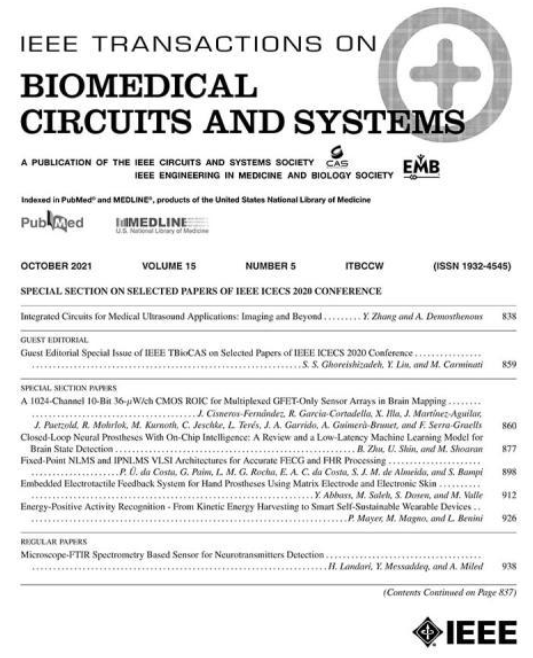基于群体感应的大肠杆菌金属离子强化检测生物传感器系统设计
IF 4.9
2区 医学
Q2 ENGINEERING, BIOMEDICAL
IEEE Transactions on Biomedical Circuits and Systems
Pub Date : 2016-01-18
DOI:10.1109/TBCAS.2015.2495151
引用次数: 10
摘要
随着近年来工业的扩张,重金属和其他污染物日益污染我们的生活环境。重金属的不可降解性可能导致其在食物链中的积累,由此产生的毒性可能对生物体造成损害。因此,检测技术逐渐受到重视。为了提高金属离子生物传感的检测性能,本文提出了一种基于群体感应(QS)的放大器。该设计利用了可扩散的信号分子,这些信号分子可以自由地穿过细胞膜进入环境,与其他分子进行通信。细菌通过细胞间的交流过程进行合作,从而显示出同步的行为,即使只有少数细胞检测到金属离子。为了便于设计,在稳态模型中描述了工程生物传感器检测金属离子的能力。采用基于遗传算法(GA)的设计方法,从相应的库中选择合适的组件,根据面向用户的规范进行设计。实验结果验证了基于群体感应的金属离子生物传感器的效率和检测性能的提高。本文章由计算机程序翻译,如有差异,请以英文原文为准。
Systematic Design of a Quorum Sensing-Based Biosensor for Enhanced Detection of Metal Ion in Escherichia Coli
With the recent industrial expansion, heavy metals and other pollutants have increasingly contaminated our living surroundings. The non-degradability of heavy metals may lead to accumulation in food chains and the resulting toxicity could cause damage in organisms. Hence, detection techniques have gradually received attention. In this study, a quorum sensing (QS)-based amplifier is introduced to improve the detection performance of metal ion biosensing. The design utilizes diffusible signal molecules, which freely pass through the cell membrane into the environment to communicate with others. Bacteria cooperate via the cell-cell communication process, thereby displaying synchronous behavior, even if only a minority of the cells detect the metal ion. In order to facilitate the design, the ability of the engineered biosensor to detect metal ion is described in a steady state model. The design can be constructed according to user-oriented specifications by selecting adequate components from corresponding libraries, with the help of a genetic algorithm (GA)-based design method. The experimental results validate enhanced efficiency and detection performance of the quorum sensing-based biosensor of metal ions.
求助全文
通过发布文献求助,成功后即可免费获取论文全文。
去求助
来源期刊

IEEE Transactions on Biomedical Circuits and Systems
工程技术-工程:电子与电气
CiteScore
10.00
自引率
13.70%
发文量
174
审稿时长
3 months
期刊介绍:
The IEEE Transactions on Biomedical Circuits and Systems addresses areas at the crossroads of Circuits and Systems and Life Sciences. The main emphasis is on microelectronic issues in a wide range of applications found in life sciences, physical sciences and engineering. The primary goal of the journal is to bridge the unique scientific and technical activities of the Circuits and Systems Society to a wide variety of related areas such as: • Bioelectronics • Implantable and wearable electronics like cochlear and retinal prosthesis, motor control, etc. • Biotechnology sensor circuits, integrated systems, and networks • Micropower imaging technology • BioMEMS • Lab-on-chip Bio-nanotechnology • Organic Semiconductors • Biomedical Engineering • Genomics and Proteomics • Neuromorphic Engineering • Smart sensors • Low power micro- and nanoelectronics • Mixed-mode system-on-chip • Wireless technology • Gene circuits and molecular circuits • System biology • Brain science and engineering: such as neuro-informatics, neural prosthesis, cognitive engineering, brain computer interface • Healthcare: information technology for biomedical, epidemiology, and other related life science applications. General, theoretical, and application-oriented papers in the abovementioned technical areas with a Circuits and Systems perspective are encouraged to publish in TBioCAS. Of special interest are biomedical-oriented papers with a Circuits and Systems angle.
 求助内容:
求助内容: 应助结果提醒方式:
应助结果提醒方式:


